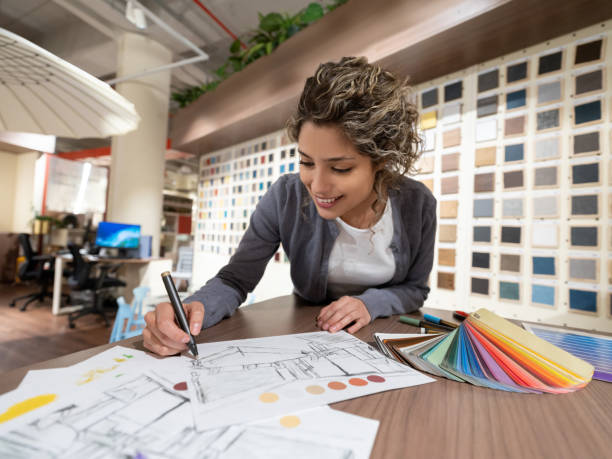Luxury home interior design is a realm where creativity meets opulence, where every detail is meticulously crafted to create a space that not only reflects the homeowner’s personality but also exudes elegance and sophistication. It goes beyond mere decoration; it’s an art form that involves a harmonious blend of aesthetics, functionality, and comfort. In this comprehensive exploration of luxury home interior design, we will delve into the principles, styles, and elements that make these spaces so captivating, without mentioning any specific brand names.
Principles of Luxury Home Interior Design
- Elegance and Sophistication Luxury interior design begins with an unwavering commitment to elegance and sophistication. It’s about creating a space that feels refined and timeless. This principle often involves the use of high-quality materials, impeccable craftsmanship, and a refined color palette.
- Functionality and Comfort While luxury homes are known for their opulence, they must also be highly functional and comfortable. The design should seamlessly integrate practicality with aesthetics, ensuring that the space meets the needs and desires of the occupants.
- Attention to Detail The devil is in the details, and in luxury interior design, every detail counts. Whether it’s the intricate carvings on a piece of furniture or the delicate patterns on a rug, attention to detail is what sets these spaces apart.
- Balance and Harmony Achieving balance and harmony in design is crucial. Luxury homes often feature a mix of textures, patterns, and materials, and it’s essential to strike the right balance to create a cohesive and visually pleasing environment.
- Personalization Luxury homes are a reflection of the homeowner’s taste and style. Personalization is key in creating a space that feels unique and tailored to the individual’s preferences.
Styles of Luxury Home Interior Design
- Classic and Traditional Classic luxury interior design draws inspiration from historical periods like the Renaissance and Baroque. It often includes ornate furniture, rich fabrics, and intricate architectural details. Classic homes exude a sense of grandeur and timelessness.
- Contemporary and Minimalistic Contemporary luxury design takes a more minimalist approach, focusing on clean lines, open spaces, and a neutral color palette. It emphasizes simplicity and often incorporates cutting-edge technology.
- Eclectic and Bohemian Eclectic luxury design embraces diversity and individuality. It involves mixing and matching various styles, colors, and textures to create a vibrant and unique interior. Bohemian influences can bring warmth and character to a space.
- Transitional Transitional design strikes a balance between classic and contemporary styles. It combines traditional elements with modern touches, creating a harmonious and timeless look.
- Art Deco Art Deco is characterized by its bold geometric shapes, rich colors, and opulent materials like brass and marble. It’s a style that harkens back to the glamour of the 1920s and 1930s.
Elements of Luxury Home Interior Design
- Materials The choice of materials plays a pivotal role in luxury interior design. Common materials include marble, granite, hardwood, and high-quality textiles like silk and velvet. These materials not only add to the aesthetic appeal but also convey a sense of opulence.
- Color Palette Luxury homes often feature a refined and muted color palette. Neutral tones like beige, ivory, and gray are prevalent, with occasional pops of rich colors to create visual interest.
- Furniture and Furnishings Furniture in luxury homes is typically custom-made or handcrafted. It’s essential to choose pieces that not only look exquisite but are also comfortable and functional. Plush sofas, elegant dining tables, and ornate headboards are staples of luxury interior design.
- Lighting Lighting is a critical aspect of luxury home design. Crystal chandeliers, wall sconces, and floor lamps add an element of glamour and drama to the space. The right lighting can enhance the overall ambiance and highlight key design elements.
- Art and Accessories Art plays a vital role in luxury interior design. Original artworks, sculptures, and unique accessories can elevate the aesthetics of a room. These pieces are often chosen carefully to complement the overall design.
- Textiles and Fabrics Luxurious textiles and fabrics like silk drapes, cashmere throws, and plush carpets are used to add texture and comfort to the space. They also contribute to the overall sense of opulence.
- Technology Integration Modern luxury homes often incorporate advanced technology seamlessly into the design. Smart home systems, automated lighting, and integrated entertainment systems enhance convenience and comfort.
Sustainable Luxury Interior Design
In recent years, there has been a growing emphasis on sustainability in luxury interior design. Many homeowners are now seeking eco-friendly and sustainable materials and practices without compromising on luxury. This trend highlights the importance of responsible design, where designers focus on minimizing environmental impact while creating exquisite interiors.
Conclusion
Hiring a professional interior decorator for luxury home interior design is an art form that blends aesthetics, functionality, and personalization to create spaces that are both exquisite and comfortable. While it can encompass a wide range of styles and elements, the principles of elegance, functionality, attention to detail, balance, and personalization remain constant. Whether it’s a classic, contemporary, eclectic, or transitional style, luxury design is a reflection of the homeowner’s taste and lifestyle. As the world evolves, so does luxury interior design, with a growing emphasis on sustainability and responsible design practices. In the end, it’s the seamless integration of these principles and styles that truly elevates the concept of luxury in home interiors.



